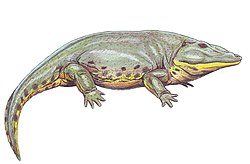| Intasuchus Temporal range: Guadalupian, | |
|---|---|
 | |
| Scientific classification | |
| Domain: | Eukaryota |
| Kingdom: | Animalia |
| Phylum: | Chordata |
| Order: | † Temnospondyli |
| Superfamily: | † Archegosauroidea (?) |
| Family: | † Intasuchidae Konzhukova, 1956 |
| Genus: | † Intasuchus Konzhukova, 1956 |
| Type species | |
| †Intasuchus silvicola Konzhukova, 1956 | |
Intasuchus is an extinct genus of temnospondyl amphibian from the Middle Permian of Russia. It is known from a single species, Intasuchus silvicola, which was named in 1956. Intasuchus belongs to the family Intasuchidae and is probably its sole member, although other taxa such as Syndyodosuchus and Cheliderpeton have been assigned to the family in the past. Intasuchus most likely belongs to the group Archegosauroidea, Permian relatives of the large, mostly Mesozoic temnospondyl clade Stereospondyli.



